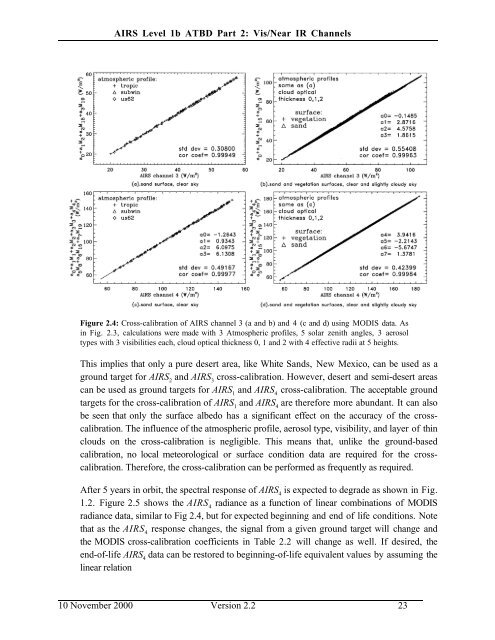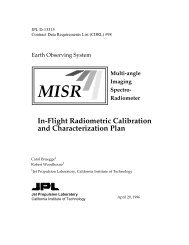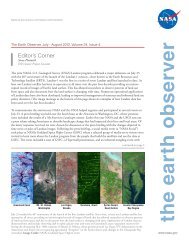AIRS Level 1B Visible/Near-Infrared Channels ATBD - NASA's Earth ...
AIRS Level 1B Visible/Near-Infrared Channels ATBD - NASA's Earth ...
AIRS Level 1B Visible/Near-Infrared Channels ATBD - NASA's Earth ...
You also want an ePaper? Increase the reach of your titles
YUMPU automatically turns print PDFs into web optimized ePapers that Google loves.
<strong>AIRS</strong> <strong>Level</strong> 1b <strong>ATBD</strong> Part 2: Vis/<strong>Near</strong> IR <strong>Channels</strong><br />
Figure 2.4: Cross-calibration of <strong>AIRS</strong> channel 3 (a and b) and 4 (c and d) using MODIS data. As<br />
in Fig. 2.3, calculations were made with 3 Atmospheric profiles, 5 solar zenith angles, 3 aerosol<br />
types with 3 visibilities each, cloud optical thickness 0, 1 and 2 with 4 effective radii at 5 heights.<br />
This implies that only a pure desert area, like White Sands, New Mexico, can be used as a<br />
ground target for <strong>AIRS</strong> 2<br />
and <strong>AIRS</strong> 3<br />
cross-calibration. However, desert and semi-desert areas<br />
can be used as ground targets for <strong>AIRS</strong> 1<br />
and <strong>AIRS</strong> 4<br />
cross-calibration. The acceptable ground<br />
targets for the cross-calibration of <strong>AIRS</strong> 1<br />
and <strong>AIRS</strong> 4<br />
are therefore more abundant. It can also<br />
be seen that only the surface albedo has a significant effect on the accuracy of the crosscalibration.<br />
The influence of the atmospheric profile, aerosol type, visibility, and layer of thin<br />
clouds on the cross-calibration is negligible. This means that, unlike the ground-based<br />
calibration, no local meteorological or surface condition data are required for the crosscalibration.<br />
Therefore, the cross-calibration can be performed as frequently as required.<br />
After 5 years in orbit, the spectral response of <strong>AIRS</strong> 4<br />
is expected to degrade as shown in Fig.<br />
1.2. Figure 2.5 shows the <strong>AIRS</strong> 4<br />
radiance as a function of linear combinations of MODIS<br />
radiance data, similar to Fig 2.4, but for expected beginning and end of life conditions. Note<br />
that as the <strong>AIRS</strong> 4<br />
response changes, the signal from a given ground target will change and<br />
the MODIS cross-calibration coefficients in Table 2.2 will change as well. If desired, the<br />
end-of-life <strong>AIRS</strong> 4<br />
data can be restored to beginning-of-life equivalent values by assuming the<br />
linear relation<br />
10 November 2000 Version 2.2 23







